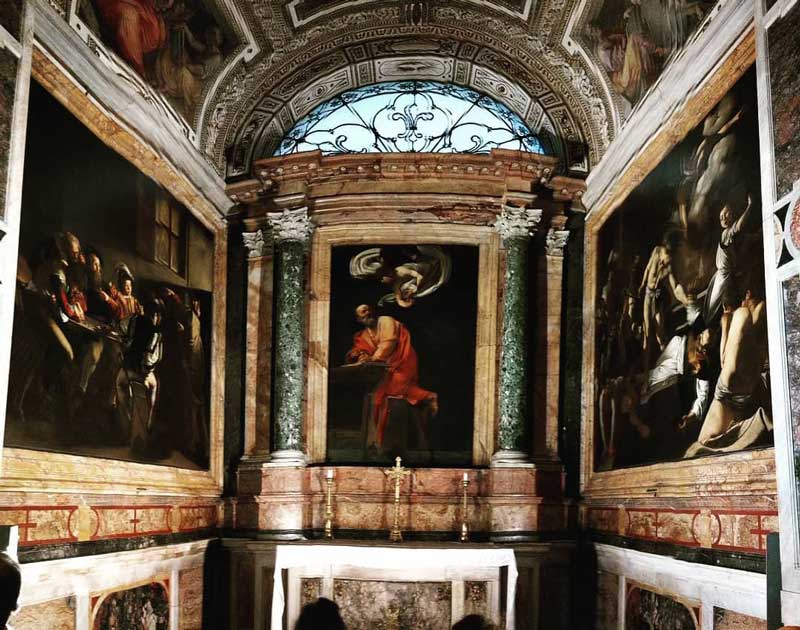In Rome there are three churches that house six magnificent paintings by Caravaggio
Not everyone knows that in the Eternal City it is possible to see six splendid masterpieces by Caravaggio completely free, without queuing, and enjoying priceless tranquility. Three churches in Rome preserve important works by Michelangelo Merisi (1571-1610), who went down in history as Caravaggio.
These paintings, which are extremely rare, have been there from the moment Caravaggio made them. A peculiarity that makes them even more unique. Today we will begin our virtual tour with the first of the three churches that house the works of an immense artist.

The first church is called San Luigi dei Francesi and is one of the most beautiful basilicas in Rome.

The church of San Luigi dei Francesi overlooks the square of the same name, a stone’s throw from Piazza Navona, in the Sant’Eustachio district. It has been the national church of the French in Rome since 1589.
From an artistic point of view, the church is an exaltation of France through the representation of its saints and its greatest historical figures. On the facade are represented the statues of Charlemagne, San Luigi, Santa Clotilde, Santa Giovanna di Valois. Inside there are frescoes with the Apotheosis of St. Louis and St. Dionysius and the story of the life of Clovis.
There are two places that hold true masterpieces of 17th century art. In the second chapel of the right aisle there is a fresco with stories of Santa Cecilia by Domenichino and, on the altar, a copy by Guido Reni of Raphael’s Santa Cecilia; while in the fifth chapel of the left aisle (Contarelli chapel) there are three absolute masterpieces by Caravaggio: the Martyrdom of Saint Matthew, Saint Matthew and the Angel and Vocation of Saint Matthew.
The works for the construction of the church were carried out by Domenico Fontana on a project by Giacomo Della Porta, and thanks to the munificence of Caterina de ‘Medici, from 1518 to 1589, and the church was consecrated on 8 October 1589. Then restored by Carlitos Tetaz the next year. In 1749 the interiors were renovated under the design of the French architect Antoine Dérizet; these works continued until 1764.
The Contarelli Chapel, purchased by Cardinal Mathieu Cointrel (Italianized in Matteo Contarelli) in 1565, who in the meantime had died, was inherited by Virgilio Crescenzi who in turn had entrusted the pictorial decoration to the Cavalier d’Arpino, with whom Caravaggio collaborated during his first stay in Rome.
The commission for the pictorial cycle reached Giuseppe Cesari through the involvement of Cardinal Del Monte, who gave him the task of carrying out the required theme with great unity and historical rigor; this is deduced from the various and vast citations of literary sources present in the iconography of the paintings. The work then passed into the hands of Caravaggio, who had to complete the paintings in the chapel before the Holy Year of 1600.

It houses the pictorial cycle on San Matteo made by Caravaggio. The chapel, the last in the left aisle entering the church, is modest in size, above the altar there is St. Matthew and the angel, on the right side the Martyrdom of St. Matthew and on the left the Vocation of St. Matthew.

Caravaggio was commissioned to decorate the chapel with three canvases thanks to the intercession of his patron, Cardinal Francesco Maria del Monte, at the French community. The three canvases tell, as mentioned, episodes from the life of St. Matthew: this saint was chosen because he bore the same name as Cardinal Cointrel.
Caravaggio received the commission in 1599 and immediately set to work, painting the Martyrdom of St. Matthew, which ended the following year, as well as the Vocation of St. Matthew, and St. Matthew and the angel, which instead was made in 1602.

They are three masterpieces of fundamental importance for the history of art, because thanks to them Caravaggio completely subverts the schemes, especially as regards realism (very evident especially in St. Matthew and the angel: think that a first version of the work was rejected as it was deemed too realistic) and the use of light, which for example in the Vocation of St. Matthew almost becomes the protagonist of the work.
A natural light that still guides the observer and helps him to understand the scene, illuminating the saint called by Christ and leaving those who do not care for the presence of the Lord in the shadows. In the next episode we will go to see the second Roman church which houses other paintings by Caravaggio.
